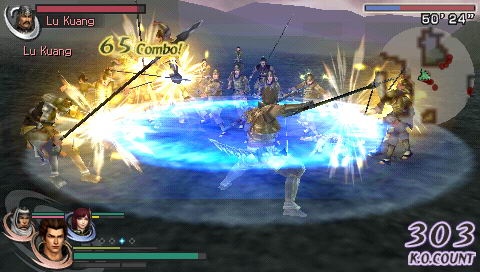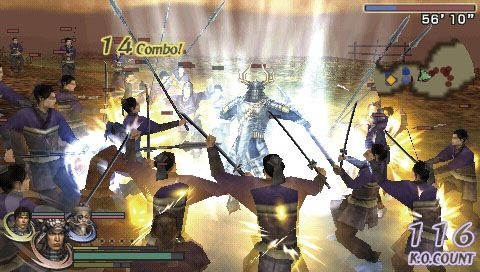Released last year for the Xbox 360 and PlayStation 2, Warriors Orochi 2 demonstrated a stalwart dedication to the shallow, repetitive gameplay that has characterized most games in the Warriors series. This hack-and-slash button masher has now made its way to the PSP, and series fans can rest easy: All the crushing boredom of the console versions has survived the transition to Sony's handheld.

The heroes of Dynasty Warriors and Samurai Warriors found themselves united by a time-bending, world-merging serpent king in Warriors Orochi. Warriors Orochi 2 carries on that crossover and introduces new characters to bring the full playable roster to a whopping 96. There are five stories to choose from in the Story mode: one for each of the three kingdoms of China, one for the samurai warriors of Japan, and one for Orochi and his followers. By this point, the personalities of these characters and the relationships between them have been developing for a long time across their respective series. The basic story of good versus evil is simple and easy to follow, but unless you're a series devotee, you'll likely find all of the name-dropping and much of the dialogue impenetrable. Who is Yoshimoto Imagawa? Why is he pining for a kemari partner? Does it matter? It doesn't help that the storytelling is terrible. There's the occasional cutscene, but for the most part, the game employs static portraits of characters who utter wooden dialogue. Most of the characters are unlikable, too; the historic personages who make up the cast are imagined here as arrogant nobles, sultry seductresses, and monosyllabic buffoons. The company of the heroes and villains alike is not enjoyable.
Each of the game's five stories takes you through a series of battles that play out in large environments. The action consists mostly of running around the battlefields and frequently pausing to tap the attack button for a while. This tapping results in the slaughter of hundreds of enemy troops who would rather stand in place and let you kill them than make any attempt to hinder your progress. You can also perform the occasional special attack, which is useful for more quickly defeating the enemy captains you encounter. Being powerful enough to slice through so many of your enemies with such ease should be intoxicating, but here, it's simply a chore. Before each mission, you compose a team of three characters, and as you play, you can switch between them on the fly, though there isn't generally much need or incentive to do so. Sure, there are 96 playable characters, but each character falls into one of just three basic categories: power, speed, and technique. Each category has its own special ability, but the differences between them have little impact on how they actually play.
While you probably won't often be threatened by enemy attacks, your allies are not so powerful or competent. During each battle, you'll receive constant updates on such things as shifts in morale and allies who are struggling elsewhere on the battlefield. This should contribute to the sense that battles are dynamic and large in scope, but in fact, very little of this information has any concrete impact on you as you run around slaughtering bad guys. There are conditions by which you can fail each battle, however. You will need to watch these updates for any mention that your main camp is in danger or that some ally who must not be defeated is struggling, so that you can hurry to the rescue. Repeatedly being forced to dash across the battlefield to rescue a helpless ally will make you feel like more of a babysitter than a powerful warrior.
Looking at the menu between battles--which features such options as abilities, character growth, and customize weapon--you might think that there are significant role-playing elements here. You do earn experience and level up over time. You can also fuse weapons to make them more powerful and unlock a host of passive abilities that you can equip your team with, such as increased speed or a gradually recharging a life bar. These aspects have little impact on the action, though, serving only to make you wish for a gameplay experience in which growth and development actually mattered.

Outside of the Story mode, there's the Free mode, which lets you take any three unlocked characters and play any scenarios you've completed from any of the game's five stories. There's also a Dream mode, which features 40 additional scenarios that take place outside the main story for those who just can't get enough of this action. And if you have a friend with the game, you can enjoy the monotony together via wireless play. Any battle can be fought cooperatively by two players who share the same team of three characters. There are also a number of competitive modes, but they're all dreadful. You can face your opponent head-on in one-on-one or tag-team fights, but the combat is much too shallow to make this a worthwhile fighting game. There's also the Tower mode in which you race your opponent to see who can knock more enemy soldiers off of a tower within a time limit. This race takes the dullest aspect of the game--fighting the rank-and-file grunts--and creates an entire mode around it. And there's the Steeplechase mode, which is a kind of kart racer on horseback with just one terrible track and slippery controls. Playing the game with a friend makes the experience less painful, but there are at least a million better ways you could spend your time.
Warriors Orochi 2's visuals are dated and ugly. The battlefields are drab and feel empty, and the enemy soldiers you kill by the dozens are featureless clones. The sound is equally awful. The music is a hodgepodge of repetitive Eastern-influenced melodies and generic electronica; the constant clash of swords is tinny and weak; and the voice acting veers between lifeless and absurdly melodramatic.
Fans that are looking for more of the same will get just that from Warriors Orochi 2. With its 96 playable characters and five stories to complete, there's enough here to keep series faithful busy for a long time. This game makes no attempt to reach out to anyone else, though, and everyone else should stay far away.